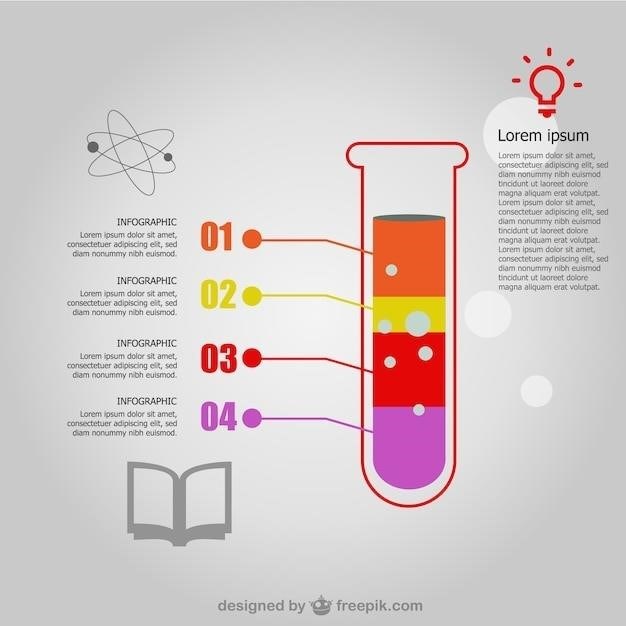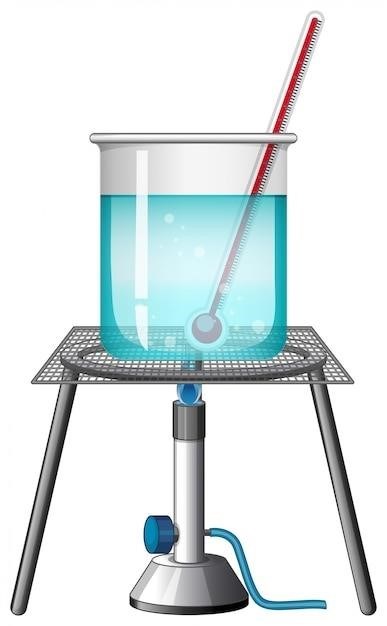
Diffusion Across Membranes⁚ A Lab Investigation
This lab explores diffusion across selectively permeable membranes. Experiments using dialysis tubing and various solutions demonstrate the principles of diffusion and osmosis. Data analysis focuses on mass change and concentration shifts, revealing factors influencing diffusion rates.
Introduction⁚ Defining Diffusion and Osmosis
This investigation delves into the fundamental processes of diffusion and osmosis, crucial for understanding cellular transport. Diffusion is the passive movement of molecules from a region of high concentration to an area of low concentration, driven by the inherent kinetic energy of molecules. This movement continues until equilibrium is reached, where the concentration is uniform throughout the system. Osmosis, a specific type of diffusion, focuses on the movement of water molecules across a selectively permeable membrane. This membrane allows the passage of water but restricts the movement of certain solutes. Water moves from a region of high water potential (low solute concentration) to a region of low water potential (high solute concentration), aiming to equalize the solute concentration on both sides of the membrane. Understanding these processes is essential for comprehending how cells maintain homeostasis and exchange materials with their surroundings. The lab will use dialysis tubing as a model membrane to explore these principles in a controlled setting.
Experimental Setup and Procedures⁚ Dialysis Tubing and Solutions
The core of this experiment involves utilizing dialysis tubing as a model for a selectively permeable cell membrane. Dialysis tubing, a semi-permeable membrane with specific pore sizes, is filled with various solutions containing different solutes, such as glucose and starch. The filled tubing, representing a cell, is then submerged in a beaker containing a different solution. The experiment carefully controls the initial concentrations of solutes inside and outside the dialysis tubing. Precise measurements of solution volumes are crucial. The setup allows the observation of solute movement across the membrane based on concentration gradients. Mass measurements of the dialysis tubing before and after a set incubation period provide quantitative data on water movement. This experimental design enables a direct examination of diffusion and osmosis principles, allowing for a clear understanding of how different molecules move across the membrane based on size and concentration gradients.
Data Collection and Observations⁚ Measuring Mass Change and Concentration
Careful observation and precise measurements are essential for accurate data collection. Before initiating the diffusion process, the initial mass of each dialysis tube is recorded. Following the incubation period, the tubes are carefully removed, gently blotted to remove excess external solution, and reweighed. The change in mass directly reflects the net movement of water across the membrane, indicating the direction of osmosis. Simultaneously, samples of the solutions inside and outside the dialysis tubing are collected for concentration analysis. Qualitative observations, such as color changes or cloudiness, are noted and documented. Quantitative concentration measurements are performed using appropriate methods, such as colorimetric assays or spectrophotometry. These measurements provide crucial data on the movement of solutes across the membrane, confirming whether or not equilibrium was reached. All data are meticulously recorded in a structured format to facilitate accurate analysis and interpretation. The combination of mass change and concentration data offers a comprehensive picture of the diffusion process.
Analysis of Results⁚ Interpreting Changes in Mass and Concentration
Analyzing the collected data involves comparing initial and final masses of the dialysis bags to determine the net water movement. A positive mass change indicates water influx, suggesting a hypotonic external solution. Conversely, a negative change suggests water efflux, pointing to a hypertonic external environment. No change in mass implies an isotonic solution. Concentration data is analyzed to determine the movement of solutes. A decrease in solute concentration inside the bag and an increase outside indicates outward diffusion. The reverse pattern suggests inward diffusion. Graphical representation of the data, such as line graphs or bar charts, helps visualize trends and relationships. Calculating the rate of diffusion, expressed as mass change per unit time or concentration change per unit time, provides a quantitative measure of the process. Statistical analysis, such as calculating means and standard deviations, increases the reliability of the conclusions. Interpretations should consider factors such as membrane permeability, solute size, and concentration gradients. Discrepancies between expected and observed results should be addressed, considering potential sources of error. A comprehensive analysis leads to accurate conclusions regarding the principles of diffusion and osmosis.
Factors Affecting Diffusion Rate⁚ Temperature, Molecular Weight, and Concentration Gradient
The rate of diffusion is significantly influenced by several key factors. Temperature plays a crucial role; higher temperatures increase kinetic energy, leading to faster molecular movement and thus a higher diffusion rate. Conversely, lower temperatures slow down molecular motion, resulting in slower diffusion. Molecular weight is another critical factor; smaller molecules diffuse more rapidly than larger ones due to their greater mobility. Larger molecules encounter more resistance as they navigate the membrane’s pores. The concentration gradient, the difference in solute concentration between two areas, is the primary driving force of diffusion. A steeper gradient (larger difference in concentration) results in a faster diffusion rate as molecules move from a region of high concentration to one of low concentration to achieve equilibrium. Membrane permeability also influences the rate; a more permeable membrane allows for faster diffusion. Other factors, such as the type of membrane and the presence of carrier molecules, can also affect diffusion rates. Understanding these factors is vital for interpreting experimental results and predicting diffusion behavior in different scenarios. Control experiments are crucial for isolating the effects of each factor, enabling clearer conclusions.
Osmosis⁚ A Special Case of Diffusion
Osmosis is a specific type of passive transport—a form of diffusion—that involves the movement of water molecules across a selectively permeable membrane. Unlike simple diffusion, which encompasses the movement of any solute, osmosis focuses solely on the movement of water. This movement is driven by the difference in water potential or, more simply, the difference in water concentration between two solutions separated by a selectively permeable membrane. Water moves from a region of higher water potential (lower solute concentration) to a region of lower water potential (higher solute concentration). This movement continues until equilibrium is reached, meaning the water potential is equal on both sides of the membrane. The concept of osmotic pressure, the pressure required to prevent osmosis, is crucial in understanding osmosis. A hypertonic solution has a higher solute concentration than the cell, causing water to move out of the cell, potentially leading to crenation (shrinking). In contrast, a hypotonic solution has a lower solute concentration than the cell, causing water to move into the cell, potentially leading to lysis (bursting). Isotonic solutions have equal solute concentrations, so there is no net water movement.
Selective Permeability of Membranes⁚ The Role of Membrane Structure
The selective permeability of cell membranes is a critical characteristic that dictates which substances can cross the membrane and at what rate. This selectivity is primarily determined by the membrane’s structure, which is a fluid mosaic model composed of a phospholipid bilayer embedded with various proteins and cholesterol molecules. The phospholipid bilayer, with its hydrophobic core and hydrophilic heads, acts as a barrier to many polar and charged molecules. Small, nonpolar molecules like oxygen and carbon dioxide can easily diffuse across the membrane. Larger or polar molecules, however, require assistance from membrane proteins. These proteins facilitate transport through various mechanisms⁚ channel proteins provide hydrophilic pathways for specific ions or molecules; carrier proteins bind to specific molecules, undergo conformational changes, and transport them across the membrane. The presence and types of these proteins, along with the fluidity of the membrane itself (influenced by cholesterol content and temperature), dictate the membrane’s selectivity. This intricate structure ensures the controlled entry and exit of essential substances, maintaining cellular homeostasis and preventing the passage of harmful molecules.
Applications of Diffusion and Osmosis⁚ Biological and Technological Examples
The principles of diffusion and osmosis are fundamental to numerous biological processes and have significant technological applications. In biology, nutrient absorption in the digestive system relies on diffusion and osmosis to move digested food molecules across intestinal cell membranes into the bloodstream. Similarly, gas exchange in the lungs depends on the diffusion of oxygen into the blood and carbon dioxide out of the blood across the thin alveolar membranes. Water balance in cells and organisms is critically maintained by osmosis, regulating the movement of water across cell membranes to prevent cell shrinkage or lysis. Kidney function, too, depends on osmotic pressure gradients to filter waste products from the blood. Technologically, these principles are exploited in various applications, including dialysis, a medical procedure that uses semi-permeable membranes to remove waste products from the blood of patients with kidney failure. Water purification systems utilize membranes to separate solutes from water, and the food industry employs osmosis in processes like dehydration and concentration of juices. The understanding and application of diffusion and osmosis continue to drive advancements in medicine, engineering, and various other fields.
Conclusion⁚ Summary and Further Exploration

This laboratory investigation successfully demonstrated the principles of diffusion and osmosis across selectively permeable membranes. Experimental observations confirmed the movement of solutes from regions of high concentration to low concentration, driven by random molecular motion. The impact of factors like molecular size, concentration gradient, and membrane permeability on diffusion rates was clearly illustrated. Osmosis, as a special case of diffusion involving water movement, was also observed and analyzed. The experiment highlighted the critical role of selective permeability in regulating substance transport across biological and synthetic membranes. Further exploration could involve investigating the effects of temperature on diffusion rates, examining different types of membranes with varying pore sizes, or exploring the role of facilitated diffusion and active transport in membrane transport. Advanced investigations could incorporate quantitative analyses of diffusion rates using mathematical models, or exploring the applications of membrane transport in more complex biological systems like plants or specialized cells.
